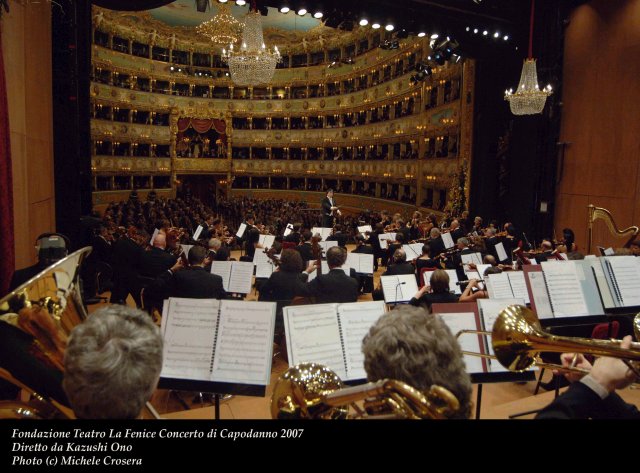la Fenice Theatre - Venice, Italy
Reborn from its ashes: like the mythological bird. The arson which burnt down the Fenice Theatre in 1996 was not the first one.
A name which wished to be a protection and a promise. The association Nobile Società dei palchettisti (Noble Society of Box-holders) which was managing the Teatro San Benedetto, the biggest of the seven theatres active in Venice in the late eighteenth century, was forced to leave the opera house as its land belonged to the Venier family. Very disappointed, but not discouraged, the associated devoted itself to building an even larger theater, and to entitle it to La Fenice a symbol of strength and capacity to rebirth. But the name did not prove to be a good omen.
The design competition was won by the architect Giannantonio Selva; works began in 1791, and it only took one year for completion. The beautiful new opera house had already gained fame in Europe, when on the night of 13 December 1836 a huge fire originated by a heater destroyed it, apart from the foyer and the Sale Apollinee.
La Fenice had to be rebuilt: the architect Giambattista Meduna directed the reconstruction works in February 1837 and completed the works in only 10 months, in a new style. Further consolidation works were necessary in 1854, when the opera house was also redecorated. Other restorations were done in 1937, and again other major works were on in 1996: in the night of 29 January the theatre was arsoned, and destroyed completely; even a great part of the Sale Apollinee this time did not survive the flames.
 |
Gala Reopening of the Teatro La Fenice / Ciofi, Ganassi, Mingardo, Sacca, Pertusi, Rivenq, Allegretta, Guadagnini. Venice Opera orchestra directed by Riccardo Muti (2003)
So Teatro la Fenice, Venice's gloriously beautiful and historically significant opera house, burned to the ground in January 1996. An eventually successful international effort to rebuild it started immediately and although it took more than seven years, with fits and starts, for the building to be rebuilt exactly as it had been before the fire, it re-opened with this gala concert featuring soloists, chorus and orchestra of La Fenice under Riccardo Muti in December 2003. The concert itself features, aside from Beethoven's second-drawer 'Consecration of the House' Overture (de rigueur in these sorts of occasions), music by composers associated with Venice. After the Italian national anthem and the Beethoven, the chorus and orchestra present Stravinsky's 'Symphony of Psalms.' Stravinsky is buried in Venice, and his Mozartean opera, 'The Rake's Progress,' was premièred at La Fenice. The three-movement Symphony is here given a lovely performance; the Fenice chorus sings radiantly, particularly in the last movement, 'Alleluja. Laudate Dominum.'
One might expect something by Vivaldi to have featured on the program; he was after all probably the composer most associated with Venice. But it is a ten-minute 'Te Deum' by his close contemporary, Antonio Caldara (1671-1736), that is presented. It is a ten-minute hymn of praise that features two quartets of vocal soloists, chorus and orchestra. It is pretty but not terribly distinguished music. The double-quartet -- which includes such emerging stars as soprano Patrizia Ciofi and contralto Sara Mingardo -- doesn't have much of interest to do.
The concert concludes with two marches by Wagner. Wagner's primary connection with Venice, as far as I know, is that he died there. The 'Kaisermarsch,' written for the dedicatinon of Bayreuth, is Wagnerian boilerplate bombast but the 'Huldigungsmarsch' is a stirring seven-minute Tristanesque tone poem, played here in its less familiar full-orchestra version; it is more generally heard as played by wind band, as it was at its première at a birthday celebration for Wagner's patron, King Ludwig of Bavaria. The performance is splendid.
The visuals of the rebuilt Teatro la Fenice show off its exquisite interior to great advantage. The gala crowd are dressed to the nines, and the audience includes the President of Italy as well as a Cardinal of the Roman Catholic Church in full regalia.
Originally broadcast on television by RAI, 14 December 2003. Sound (Dolby 5.1, DTS 5.1 or LPCM Stereo) is adequate but not overwhelmingly rich. There are no subtitles and no extra features. Liner notes are in German, English and Italian. TT=66 mins.
(review by Scott Morrison)
